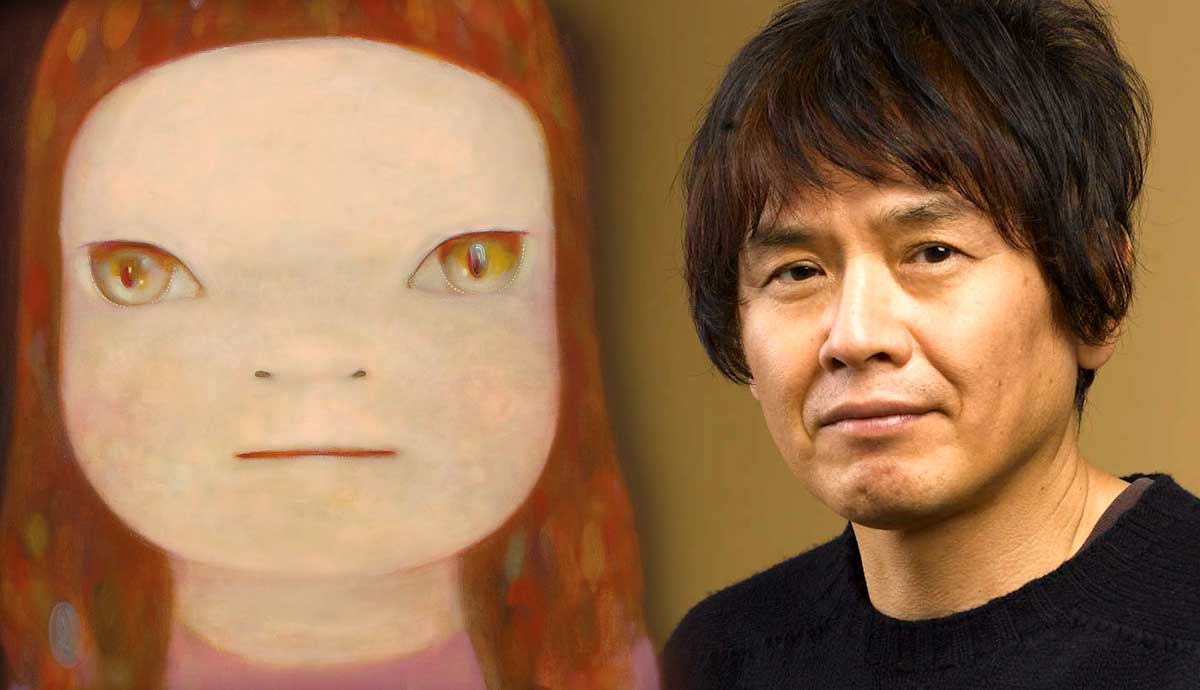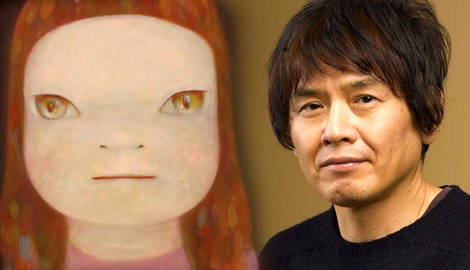
Yoshimoto Nara is an important artist of the Japanese Neo-Pop movement. He is known for the cartoonish characters in his paintings, sculptures, and sketches. Punk rock, manga, Disney, and anime are just a few of the things that have had a big impact on his work. These influences result in endearing images that are also eerily threatening and disturbing, which helps them stand out in today’s aggressive, rapidly transforming modern society.
Who is Yoshimoto Nara?

In the northernmost Japanese prefecture of Aomori, Yoshimoto Nara, the youngest of his three brothers, spent his childhood in a remote area close to the town of Hirosaki. Further in his artistic career, Nara would take cues from the mystical doctrine of Shinto, which he had learned from his family of Shinto priests. Nara’s childhood was quite lonely. His siblings were 10 years older than him and his parents had demanding jobs. He was a sensitive person who struggled with his feelings. Nara grew up surrounded by both Japanese and American modern media, the latter of which had swamped Japan in the wake of World War II. Fairy Tales, children’s books, Disney movies, rock music, American comic books, Warner Brothers cartoons, and punk music were just a few of the many inspirations that Nara drew from.
He founded a coffeehouse in his neighborhood with a classmate when he was sixteen where he served as the disc jockey. He drew inspiration from both the contemporary arts of music and the confrontational mentality expressed in punk music. Nara also got his start in art at an early age. He began by creating shapes from clay (or, supposedly, his own feces), and after that, he tried sketching.

Nara had intended to major in literature, but when a colleague commended one of his creations, he changed his mind and opted for a potential career in painting. With his family’s support, Nara relocated to Nagatuke to attend the Aichi Prefectural University of Fine Arts and Music. He received his bachelor’s degree in fine arts in 1985 and his MA shortly afterward. Nara relocated to Düsseldorf after getting his MA and attended the Kunstakademie Düsseldorf between 1988 and 1993 to further his art studies.
While residing in Germany from 1988 to 1993, Nara served a six-year internship at the Düsseldorf branch of the German Academy of Arts. A R Penck, a German artist, served as his tutor. He had a great deal of interest in Punk rock and Neo-Expressionism around this time. He established himself as a teacher by instructing high school pupils in painting while not in class, allowing him to have more freedom with his finances. Many highly emotional aesthetic motifs from German Neo-Expressionism, including the emotive, harsh, and even violent brushwork and vibrant colors popularized by artists like Georg Baselitz, influenced Nara.

The Fukushima tsunami and earthquake in 2011 caused a crisis at the Fukushima Daiichi Nuclear Power Plant that was only comparable in severity to Chornobyl. These related incidents, which happened close to the artist’s native town, profoundly traumatized Nara. Nara’s depression over the realization that everything he had previously accomplished with life was completely pointless and worthless, prevented him from drawing. Finally, he witnessed others who had been driven from their houses by the catastrophe starting to come back and re-establishing themselves. This gave him the strength to pick up his own artistic pursuits once more.
Since 2014, Nara has developed a passion for discovering his personal ancestry and has used photography to document his experience. For example, in Sakhalin (Russia), he went to the old mines where his grandfather had worked. He came to understand that what he had been witnessing was not Japan or Russia, but rather a region that lay somewhere in between. He started to feel pulled to anything that lies in between, stuff that is neither this nor that. This is the reason why his art, especially the contrast between both the West and the East, conveyed this feeling of harmonic paradox. Nowadays, Nara has two studio locations: one in Japan and the other in Germany.
The Trailblazer Artist of the Superflat

During the 1990s Japanese Pop art movement, Yoshimoto Nara began his ascent to notoriety in the art sphere. The phrase Superflat art, which a fellow artist Takashi Murakami invented to characterize a style that combined two-dimensional graphic design with the more reflective interests of fine art, is uniquely linked to Nara.
The majority of Nara’s paintings portray a single, relatively inconsequential subject without any or little context, making their subjects appear deceptively straightforward. These kids, however, who at first glance seem adorable and even helpless, occasionally carry around blades and other weapons. They frequently have accusing stares in their big eyes.
Nara is sometimes linked to the customs of Japanese anime and manga, although his works draw from a far wider spectrum of sources, from Eastern philosophical and religious traditions to Occidental Punk Rock. Although Nara focused on sculpting and installations of artwork in the late, more reflective period of his career, he is probably best known for his Ramona portraits.

The Girl with the Knife in Her Hand is one of his earlier pieces. It exemplifies Nara’s distinctive style, which features two-dimensional, flat kids with pink cheeks and large eyes set against bare or unremarkable backdrops. These iconic characters, known in Japan as kawaii, are typically shown outside of familiar settings, giving them a timeless charm that exceeds space and time.
The effects of the Fukushima disaster (2011) and the passing of his father directly influenced the spiritual emphasis of Nara’s mature compositions. He developed into an increasingly intellectual and contemplative artist, inspiring his viewers to reach a higher state of awareness via his work.
The Macabre in Innocence

The children in Nara’s paintings are both charming and mischievous. They have typical youthful characteristics like chubby cheeks, huge puppy eyes, and tiny lips. People often smile when they look at these comical artworks, remembering their youth with warmth and nostalgia. This type of work is part of the global kawaii movement, which refers to people’s obsession with cute things.

A recurring figure from Nara, dubbed Ramona after the American Punk band The Ramones, can be seen in this enormous work. Ramona is a youthful-looking girl in a red outfit that scowls and gives the audience a rebellious stare. Only the work’s title reveals that she is wielding a knife because her arm is concealed behind her back.
The danger of the knife is made immensely more menacing by keeping it hidden, highlighting the children’s unanticipated insurgent power and the radical potentiality of the imagined that goes along with it. This served as the inspiration for Nara’s epoch-defining iconography of morose, unhappy youngsters who were yet lovable and alluring. The piece was made at a period when Nara was redefining his own aesthetic, turning away from the bold colors and thick, black neo-expressionist lines that he had utilized in the 1990s.

In Star Island, three heads, a dog, and many stars are depicted on a plain turquoise backdrop, which contrasts with some of Nara’s most well-known themes. However, the nuanced feelings that can be inferred from the human figures’ expressions, as well as the allegory present in the other components point to a deeper layer of meanings centered on concepts like youth, revolt, and the exploration of one’s uniqueness in modern society. The Dogs’ submission and deference serve as a metaphor for kids’ conduct in Nara’s eyes. In his works, both kids and dogs are employed as identical representations of naivety, frailty, and solitude.
The dog and one of the girls have their eyes shut in Star Island, and characters with shut eyes developed into a recurring motif in the artist’s later more contemplative works. The four-pointed stars, on the other hand, have a purpose that goes much beyond simple ornamentation.
For Nara, the stars indicate a variety of typical juvenile clichés, such as getting a gold star in class for a job well done. The figures depicted beside the stars’ various expressions hint at the variety of reactions that these connotations provoke, and the picture may therefore be seen as either one of sarcasm or optimism.

The White Dog images by Nara have turned out to be one of his best-known works. The friendly creature has inspired toys, T-shirt prints, novelty goods, and souvenirs. His white dog powerfully suggests Buddhist meditation with its fixed gaze and practiced attitude. In contrast, the white hue has a significant connection to the Japanese concept of the white ghost spirit. It also evokes komainu, the mythological figure resembling a lion that is frequently employed as a protector sign at the doorway to sacred temples and shrines.
The sculpture provides an infant’s distinct viewpoint in terms of size and sensation, with the animal looking bigger than life. The concept of self-separation and solitude, which Nara has mentioned before when talking about his youth, is conveyed generally in a rather melancholic manner. In a way, it symbolizes an escape from realism into the innermost world.

In Nara’s work Fire, a tiny home is on fire with smoke rising upward, as a young child stares over what seems to be a table. The artwork’s straightforward formal style enables the observer to concentrate on the child’s emotional condition. She clearly finds the flaming house to be fascinating. But, her eyes convey a touch of malice, hence, we may safely assume that the child (Ramona, as she has come to be known throughout Nara’s work) is the one who started the fire in the first place.

Early works by Nara are the pinnacle of Japanese Pop Art. His paintings and sculptures appeal to Pop principles of bulk manufacturing, and the subversive and rebellious themes that Punk led him to explore lure a large adolescent audience. In stark contrast to his previous Ramonas, Yoshimoto’s Midnight series displayed a pronounced Buddhist perspective. Although he claims that it is not his responsibility to teach others, he does feel that if someone has the right awareness, knowledge, or even only the potential for such insights, it will enable them to have a better awareness of his artistic realm.
Yoshimoto Nara: Face of an Artistic Rebellion

Punk Rock music and the spirit of resistance and rebelliousness serve as major inspirations in countless of Nara’s creations. Otafuku, a character from the conventional Japanese theatre that symbolizes delight and is typically shown with chubby cheeks and cheery eyes, is transformed into a naughty, gloomy youngster in Nara’s work. Even the idea that Japan has a rigid culture dominated by antiquated social norms has been challenged by his artwork.

Nara’s cartoonish style has occasionally been linked to Keith Haring. However, Nara’s characters are more stereotypical and flirt with the cutesy culture of Japan. Like Haring’s, though, his artworks have captured the attention of both professional art experts and youth groups.










